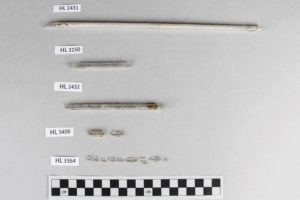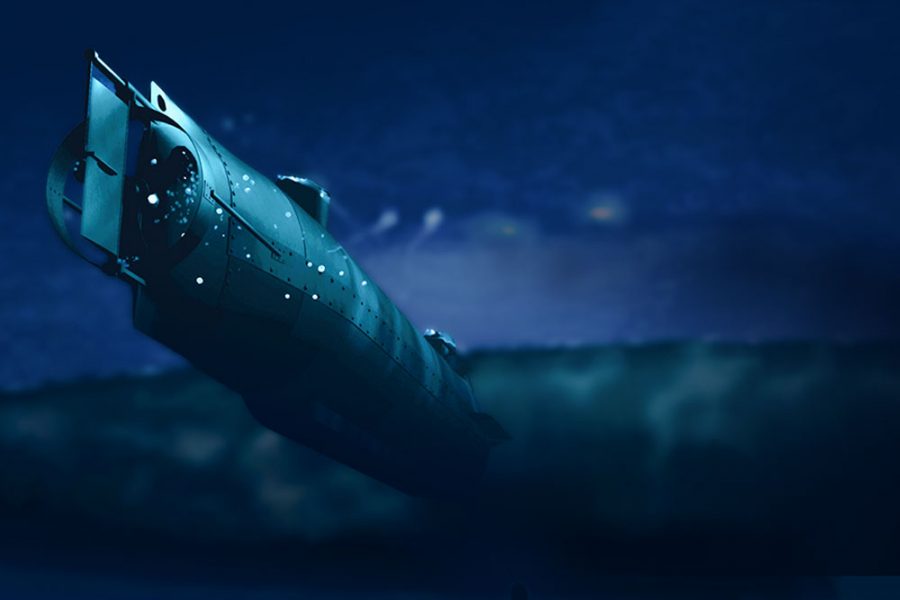The Hunley’s journey to become the world’s first successful combat submarine is full of twists, turns and, of course, dives. From her initial development in Mobile, Alabama in 1863 to the next year’s February attack that earned her place in the history books, the pioneering submarine underwent major changes in her mode of attack and weapon’s system. An artifact found in the Captain’s station of the crew compartment is helping illustrate this process of innovation and evolution. It is also teaching us the many challenges faced by those adventurous souls who volunteered to man such a dangerous vessel.
The artifact was found in several pieces during excavation: a wooden board, fragments of glass pipe, mercury, and iron tubing. Once the different components were collected, it was clear scientists had uncovered a 19th-century depth gauge. Finding a depth gauge on a submarine was not surprising given the need to dive and operate underwater. What is puzzling is it appears the crew may have disabled the gauge the night the Hunley vanished. A brief look at history explains why they may have made this decision.

Depth gauge glass tubing sections found near the pilot station.
Developing the Hunley as a Weapon
During the American Civil War, the Confederate Navy was outnumbered and outgunned by the larger and more advanced Union fleet. This required the South to rely on creative new approaches to combat the Union Navy and its many advantages. It is from this historical backdrop that the Hunley emerged.
Beginning in 1862, several engineers and financiers banded together and decided to take the battle beneath the water’s surface. Led by Horace L. Hunley, the group developed a series of three prototype submarines. Learning from and improving on each attempt, their final effort proved by far the most successful.
The Hunley was initially designed to dive completely below her target while towing behind a floating torpedo on a 200-foot tether. Once the submarine dove and passed under the keel of her target, the torpedo would impact its hull on the other side, in theory causing a devastating explosion that would sink the ship. For this attack strategy, the depth gauge was essential.
To safely dive under a Union vessel, the Captain would need to carefully maneuver the five-foot tall submarine between the ocean bottom and the keel of the target ship. With little room for error, the depth gauge provided key information in what could often be a tight squeeze. And the gauge likely helped in July 1863 when a demonstration of the Hunley’s attack capabilities was conducted in Mobile Bay.
The Hunley successfully sank a flat-bottomed barge that was anchored in the bay. On hand to witness the display were several high ranking officials including Admiral Franklin Buchanan, Mobile’s Naval Commandant. He immediately wrote a report to General P. G. T. Beauregard, officer in command of Confederate forces in the key port city of Charleston, South Carolina. In his account Buchanan said: “I am fully satisfied [the Hunley] can be used successfully in blowing up one or more of the enemy’s Iron Clads in your harbor.” The Hunley was quickly sent to Charleston to help break the blockade that was stopping the flow of supplies to the Confederacy.
Changing the Strategy
The Hunley arrived that next month. Tragically, the submarine did not meet the same success in the choppy waters off the coast of Charleston.
In August and October of 1863, two fatal test missions led to the loss of over a dozen men. Then the situation got worse.
The Hunley’s sinking and the visible recovery efforts that followed had created quite a stir in Charleston. It was not long before Rear Admiral John Dahlgren, the head of the Union blockading fleet, learned of the diving submarine from Confederate deserters. In response, Dahlgren ordered his blockading squadron to anchor in shallow water, hang ropes and chains over their sides as defensive measures, and deploy picket craft to keep torpedo-bearing boats away. These clever tactics were also the genesis of anti-submarine countermeasures.
Confederate General Beauregard was reluctant to put the Hunley back in service, writing: “It is more dangerous to those who use it than to the enemy.” Still, the submarine had persuasive backers including Lieutenants George Dixon and William Alexander, both of whom passionately believed she could be successful in breaking the blockade. Even their faith in the Hunley didn’t blind them to the fact that they needed to adapt. The Union’s anti-submarine moves coupled with the difficulty of controlling the Hunley’s depth and pitch while submerged led them to completely rethink the mode of attack.
Towing an explosive device was abandoned for a more direct approach. A spar with a torpedo attached to its tip was mounted to the lower bow of the submarine. Though the actual design is unclear, the plan was either to ram the spar into the hull of an enemy ship, detonating the torpedo on contact, or to position the torpedo under the ship keel and pull a detonating lanyard. It was perhaps efficient but, with a sixteen-foot spar, it left the crew dangerously close to the explosion.
There was little time, if any, to test the new attack strategy. Under Dixon’s persistence, reluctantly, General Beauregard finally agreed to let the Hunley try again, but only if the submarine did not dive and operated at the surface.

Was the Depth Gauge Used the Night of the Attack?
On the night of February 17th, 1864, the Hunley embarked on her mission to sink a Union blockader. She was successful and achieved a maritime first with the sinking of the USS Housatonic. The Hunley and her crew vanished shortly after the attack leaving no survivors to tell the story from their perspective. There were, however, many survivors from the Housatonic, who later gave eyewitness testimony that the Hunley had attacked only partially submerged in the water.
During preservation, scientists found a wooden plug jammed into the coupling used to hold the glass, which disabled the depth gauge. Perhaps this was because there was little use for it since the new mode of attack did not require a deep dive.
Based on these historical events and accounts, it was likely the depth gauge was not needed during the attack. So why did the crew bring the gauge onboard? In the small confines of the crew compartment, every free inch was needed for ease of navigation. Perhaps they wanted to protect the gauge from the explosion while keeping the option to use the gauge as part of their escape after the attack?
The sinking of the Housatonic did not go unnoticed in the Harbor that night. The Hunley crew would have known it would be impossible for their departure to go undetected by the other ships in the Union fleet. Did the Hunley’s Captain consider submerging after the attack to evade the warships that would come to the Housatonic’s aid? Or, perhaps he planned to place the Hunley on the bottom following the attack to wait several hours for the tide to change so they could more easily ride it back to shore just as the ebb tide had more swiftly brought them out to the Housatonic.
Telling the Hunley Story
The depth gauge illustrates the complexities surrounding the Hunley story. In a time of war and desperation, those who were moving the submarine project forward were forced to take major risks and quickly adapt. In July of 1863, the depth gauge was essential for the Hunley and her crew’s survival. Then, only six short months later, it was practically irrelevant to the attack. The artifact may have once been needed to see how deep the submarine could go, but today it is a symbol of how quickly the tides were changing during the brief, tumultuous history of the Hunley.
How Did the Depth Gauge Work?
The depth gauge was mounted on a wood board bolted to the forward ballast tank bulkhead right inside the Captain’s station. It worked by sea pressure making mercury levels rise and fall inside its metal and glass tubing. Depth markings may have been inscribed directly on the upper board or on a piece of paper attached to the board. Unfortunately, any markings or paper would have dissolved or degraded over the years entombed in the sea.
Comparing the glass scale height with the relative heights of the depth gauge, its components and other hull features, researchers think the gauge could display a depth change of about thirty feet. This means the pilot likely knew from the gauge reading when the hatches were from zero to thirty feet underwater. Similarly, by adding the submarine height, he also knew when the bottom of the keel blocks were from five to 35 feet underwater. From this analysis and historical records, scientists estimate the Hunley was designed to operate at least forty feet underwater and survived a sinking in October 1863 to over 50 feet.



